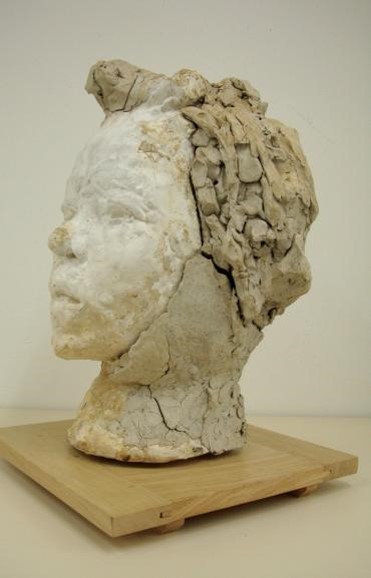- Home
- News
- General News
- Rodin’s modelling...
Rodin’s modelling techniques brought to light
01-03-2016
Advanced synchrotron imaging techniques have helped conservators gain insight into the techniques employed by Auguste Rodin at the beginning of the 20th century in the making of his sculptures with modern modelling materials and have participated in developing adapted protocols for the restoration of badly degraded models.
When the Rodin museum was preparing the exhibition “Portrait-making. Rodin and his models”, two busts were in such a bad state of conservation that it was impossible to handle or exhibit them. These busts, Hanako dating from 1908-1912(?) and Clemenceau, 1911-1913, needed to be restored before exhibiting them. The two sculptures contain pieces of non-drying modern modelling materials invented at the end of the 19th Century as an alternative to clay or waxes. These models were a way for Rodin to practice repeatedly until achieving the optimum form and as such offer great insight into the creative process of the sculptor and the techniques he developed.
At the time when Rodin was making his sculptures, and indeed since antiquity, clay or waxy natural materials such as beeswax were often used for sculpture. Some additives such as minerals, starch or pine resin could also be mixed with these waxy materials to change the physical properties or aspect. However around this time synthetic materials, like paraffin, Japan wax or stearin also emerged to provide an alternative to beeswax. A new material – Plastiline - made of kaolin and native sulphur mixed with lanoline or glycerine was formulated in Italy. In England Plasticine was created based on undefined waxy material and oil and which could be mixed with pigments.
Given the various possible compositions of the modelling material used in sculptures, the Rodin museum called upon a team of French scientists to identify the composition of the specific modelling materials used by Rodin. Through the characterisation of these materials the scientists would then be able to establish hypotheses on the origins of their degradation.
 |
 |
| Hanako (Musée Rodin) left: before conservation, right: after conservation. Copyright: Bluzat, Cascio, Mary. | |
« Thanks to the Musée Rodin and the support of a sponsor, we were able to carry out this important preliminary study and the unrivalled restoration that followed! It is still rare for us, as independent restorers, to have these research opportunities, and we would like to develop other such opportunities. This work has been very rewarding, in particular through the close collaboration with the scientific team”, said Hélène Bluzat, independent restorer and one of the three-person restoration team.
As a complement to laboratory techniques such as gas chromatography coupled to mass spectrometry, infrared spectroscopy, X-ray diffraction, visible and electron microscopy carried out at the Centre of Research and Restoration of French Museums, Paris, the scientists used the ultra bright X-rays on the ESRF’s ID21 beamline to analyse tiny fragments taken from different sculptures. The sample size was no bigger than 1 mm³.
 |
|
Macroscopic picture of a modelling material fragment showing different degradation features (cracks on the left, grey and black dust on the surface, presence of many white protrusions), but also showing a finger print, possibly of Rodin. |
The studies revealed that Rodin used at least two different types of modern modelling materials and that their compositions are close to the original Plastiline and Plasticine recipes of the era. The busts to be restored, Hanako and Clemenceau, both contain paraffin and fatty matter filled with calcium carbonate. More particularly, micro-analyses carried out at ID21 aimed at understanding degradation phenomena, and at specifically identifying degradation products, present at the surface of the sculptures. Different components were analysed, such as dust (giving a grey aspect to the original white material), an organic layer, made of calcium soaps, covering the surface and giving a fatty yellow aspect and some small crystallized aggregates distributed here and there, at the surface of the materials, and made of sulphates, magnesium and sodium mainly. Conversely to the fatty matter, the calcium carbonate which is constitutive of the modelling material and gives it its ivory colour does not release in the upper greasy layer, hence the difference of colours observed on the surface. “The difficulty with such materials is their intrinsic complexity, due to both the original recipes which usually mix different organic and inorganic ingredients, but also the new materials and new compositions formed upon aging, by release and/or chemical modification of some original components. The ID21 beamline is particularly useful for such studies since it offers a set of different techniques, in particular infrared spectroscopy for the analysis of organic matter and X-ray spectroscopy, both with sub micrometric resolution”, explains Marine Cotte, scientist in charge of the beamline and involved in the research.
| These two short videos show laser cleaning techniques being applied to Rodin's Hanako bust during conservation. Credit: Bluzat, Cascio, Mary. | |
In parallel to these investigations, various cleaning and conservation protocols were developed by a team of French curators in order to find the optimum treatments adapted to such unusual materials. Details as subtle as fingerprints could be preserved. As seen in the two busts of Hanako above, the final state of the sculpture is impressive and gives a very good idea of the original aspect of the models after Rodin’s creation.
Principal publication and authors
Analysis and conservation of modern modeling materials found in Auguste Rodin's sculptures. Juliette Langlois, Guylaine Mary, Hélène Bluzat, Agnès Cascio, Nathalie Balcar, Yannick Vandenberghe, Marine Cotte. Studies in Conservation. doi/10.1080/00393630.2015.1131029
Get the PDF version of the publication.
Top image: Clemenceau bust (Musée Rodin) during conservation treatment by laser cleaning. Credit: Bluzat, Cascio, Mary.




